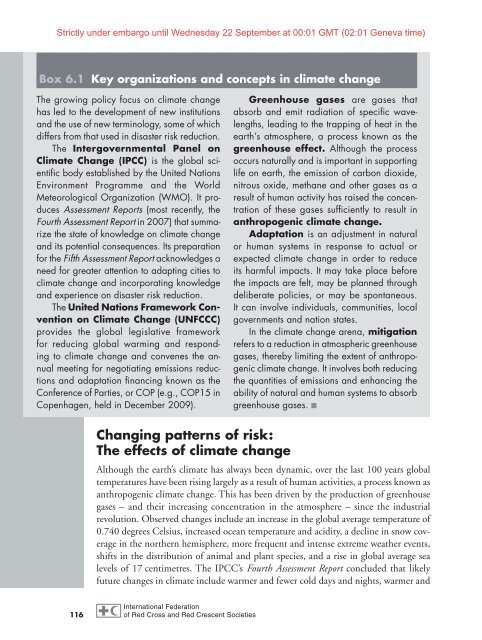chapter 4 - DRK
chapter 4 - DRK
chapter 4 - DRK
Create successful ePaper yourself
Turn your PDF publications into a flip-book with our unique Google optimized e-Paper software.
Strictly under embargo until Wednesday 22 September at 00:01 GMT (02:01 Geneva time)Box 6.1 Key organizations and concepts in climate changeThe growing policy focus on climate changehas led to the development of new institutionsand the use of new terminology, some of whichdiffers from that used in disaster risk reduction.The Intergovernmental Panel onClimate Change (IPCC) is the global scientificbody established by the United NationsEnvironment Programme and the WorldMeteorological Organization (WMO). It producesAssessment Reports (most recently, theFourth Assessment Report in 2007) that summarizethe state of knowledge on climate changeand its potential consequences. Its preparationfor the Fifth Assessment Report acknowledges aneed for greater attention to adapting cities toclimate change and incorporating knowledgeand experience on disaster risk reduction.The United Nations Framework Conventionon Climate Change (UNFCCC)provides the global legislative frameworkfor reducing global warming and respondingto climate change and convenes the annualmeeting for negotiating emissions reductionsand adaptation financing known as theConference of Parties, or COP (e.g., COP15 inCopenhagen, held in December 2009).Greenhouse gases are gases thatab sorb and emit radiation of specific wavelengths,leading to the trapping of heat in theearth’s atmosphere, a process known as thegreenhouse effect. Although the processoccurs naturally and is important in supportinglife on earth, the emission of carbon dioxide,nitrous oxide, methane and other gases as aresult of human activity has raised the concentrationof these gases sufficiently to result inanthropogenic climate change.Adaptation is an adjustment in naturalor human systems in response to actual orexpected climate change in order to reduceits harmful impacts. It may take place beforethe impacts are felt, may be planned throughdeliberate policies, or may be spontaneous.It can involve individuals, communities, localgovernments and nation states.In the climate change arena, mitigationrefers to a reduction in atmospheric greenhousegases, thereby limiting the extent of anthropogenicclimate change. It involves both reducingthe quantities of emissions and enhancing theability of natural and human systems to absorbgreenhouse gases. Changing patterns of risk :The effects of climate changeAlthough the earth’s climate has always been dynamic, over the last 100 years globaltemperatures have been rising largely as a result of human activities, a process known asanthropogenic climate change. This has been driven by the production of greenhousegases – and their increasing concentration in the atmosphere – since the industrialrevolution. Observed changes include an increase in the global average temperature of0.740 degrees Celsius, increased ocean temperature and acidity, a decline in snow coveragein the northern hemisphere, more frequent and intense extreme weather events,shifts in the distribution of animal and plant species, and a rise in global average sealevels of 17 centimetres. The IPCC’s Fourth Assessment Report concluded that likelyfuture changes in climate include warmer and fewer cold days and nights, warmer and116
















